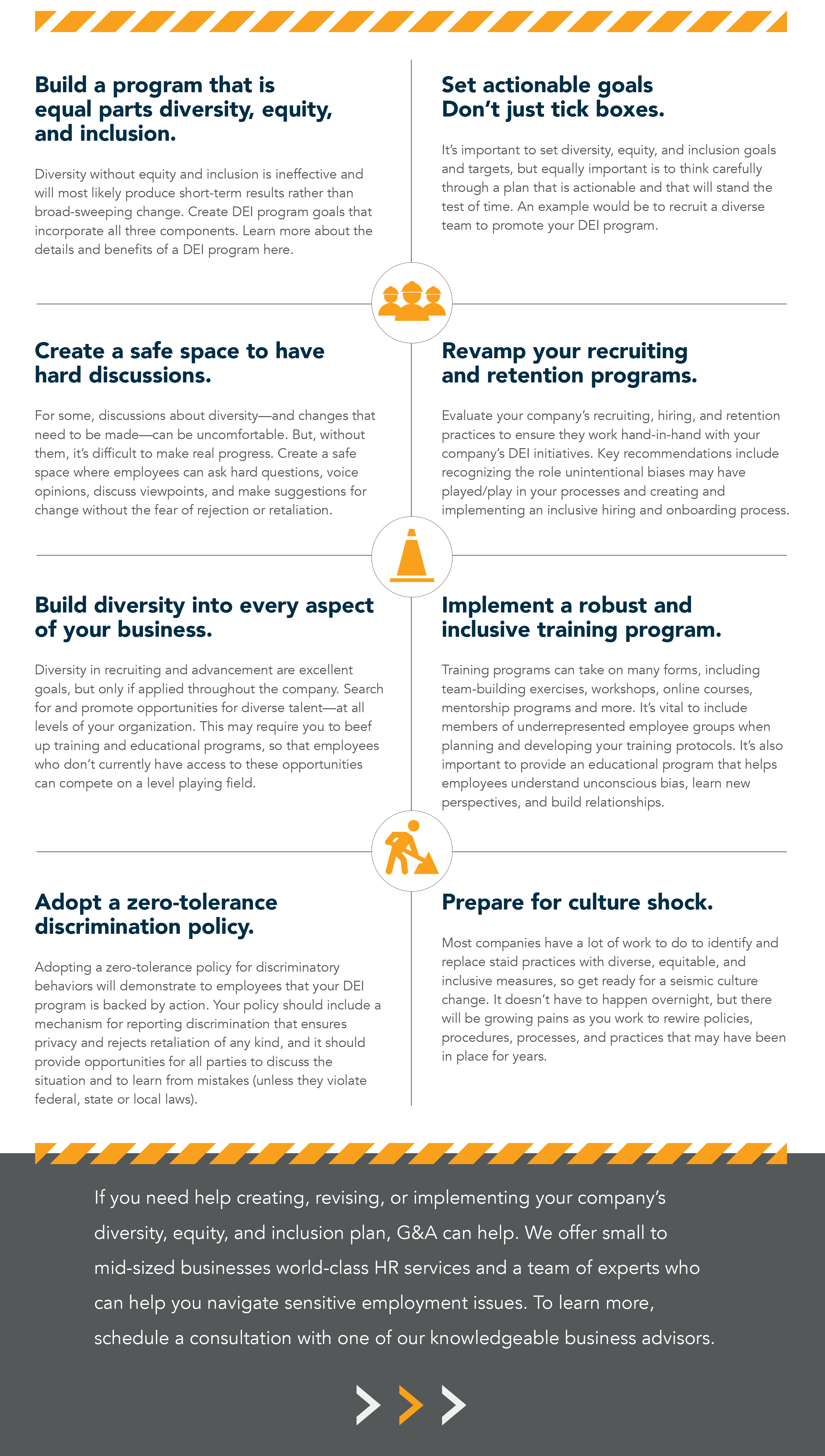See Text Version of Infographic
A DEI Program Isn’t Built in a Day
Creating and implementing a Diversity, Equity and Inclusion (DEI) program for your organization—and successfully incorporating it into the day-to-day culture of your workplace—can have a lasting and beneficial impact on your company and your employees. Below are tips and suggestions to help you start the process of creating (or refining) your own successful and sustainable DEI program.
- Build a program that is equal parts diversity, equity, and inclusion.
Diversity without equity and inclusion is ineffective and will most likely produce short-term results rather than broad-sweeping change. Create DEI program goals that incorporate all three components. Learn more about the details and benefits of a DEI program here. - Set actionable goals. Don’t just tick boxes.
It’s important to set diversity, equity, and inclusion goals and targets, but equally important is to think carefully through a plan that is actionable and that will stand the test of time. An example would be to recruit a diverse team to promote your DEI program. - Create a safe space to have hard discussions.
For some, discussions about diversity—and changes that need to be made—can be uncomfortable. But, without them, it’s difficult to make real progress. Create a safe space where employees can ask hard questions, voice opinions, discuss viewpoints, and make suggestions for change without the fear of rejection or retaliation. - Revamp your recruiting and retention programs.
Evaluate your company’s recruiting, hiring, and retention practices to ensure they work hand-in-hand with your company’s DEI initiatives. Key recommendations include recognizing the role unintentional biases may have played/play in your processes and creating and implementing an inclusive hiring and onboarding process. - Build diversity into every aspect of your business.
Diversity in recruiting and advancement are excellent goals, but only if applied throughout the company. Search for and promote opportunities for diverse talent—at all levels of your organization. This may require you to beef up training and educational programs, so that employees who don’t currently have access to these opportunities can compete on a level playing field. - Implement a robust and inclusive training program.
Training programs can take on many forms, including team-building exercises, workshops, online courses, mentorship programs and more. It’s vital to include members of underrepresented employee groups when planning and developing your training protocols. It’s also important to provide an educational program that helps employees understand unconscious bias, learn new perspectives and build relationships. - Adopt a zero-tolerance discrimination policy.
Adopting a zero-tolerance policy for discriminatory behaviors will demonstrate to employees that your DEI program is backed by action. Your policy should include a mechanism for reporting discrimination that ensures privacy and rejects retaliation of any kind, and it should provide opportunities for all parties to discuss the situation and to learn from mistakes (unless they violate federal, state or local laws). - Prepare for culture shock.
Most companies have a lot of work to do to identify and replace staid practices with diverse, equitable and inclusive measures, so get ready for a seismic culture change. It doesn’t have to happen overnight, but there will be growing pains as you work to rewire policies, procedures, processes and practices that may have been in place for years.
If you need help creating, revising, or implementing your company’s diversity, equity, and inclusion plan, G&A can help. We offer small to mid-sized businesses world-class HR services and a team of experts who can help you navigate sensitive employment issues. To learn more, schedule a consultation with one of our knowledgeable business advisors.


